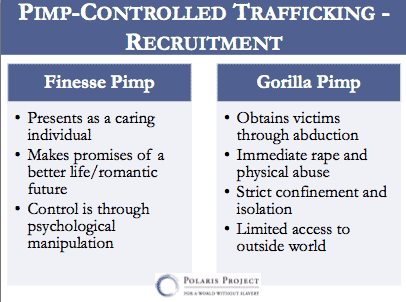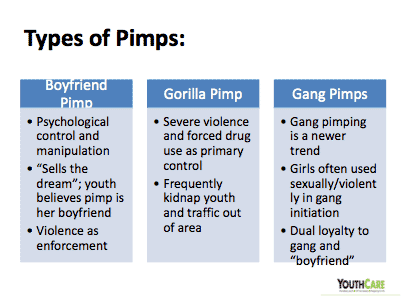Popular discourse surrounding human trafficking in the U.S. have gone through several transformations since the dawn of this century. For example in 2000, with the passage of Trafficking Victims Protection Act in the United States. and the adoption of the Protocol to Prevent, Suppress and Punish Trafficking in Persons by the United Nations (as a supplement to its Convention against Transnational Organized Crime), “human trafficking” began to be understood primarily as a transnational criminal enterprise comparable to illegal trafficking of weapons and drugs. This perspective is a distinct departure from the more traditional approach which dealt with human trafficking in relation to poverty, migration, labor, and development.
The next transformation took place around 2008-2009, when American media and politicians began focusing (sometimes exclusively) on domestic minor sex trafficking (DMST) or commercial sexual exploitation of children (CSEC–although I believe it should be called CSEY with the word “youth”), instead of the more traditional emphasis on foreign victims who are trafficked transnationally. The frequency of media coverage of DMST/CSEY exploded, as did the number of “anti-trafficking” groups (which mostly focus on DMST/CSEY) in the U.S., and the sensationalistic rhetoric of “modern day slavery” and “sex slaves” became commonplace.
There is yet another rhetorical and substantiative transformation of the U.S. anti-trafficking discourse taking place today, even though few people outside of the law enforcement and anti-trafficking groups that partner with them are taking notice. The shift I am pointing out is the recent move by the U.S. government agencies to re-classify DMST/CSEY as a primarily “gang” issue and take actions accordingly.
This is a trend I’ve been sensing for a while, but it was not until I heard directly from a staffer at the U.S. Attorney’s Office of Oregon that it had moved the issue of DMST/CSEY to the purview of its “gang unit” (as opposed to the civil rights division, which handles transnational labor trafficking) that I began to realize that there is something to the vague suspicion I had been feeling. Further research has confirmed that there is a deliberate shift in rhetoric and strategy U.S. government agencies and its allied anti-trafficking groups employ in their campaigns against DMST/CSEY.
Media reports about DMST/CSEY involving street gangs precede official government declarations by two to three years. They first began appearing in the U.S. context in 2008, when teenage gang members were arrested for “sexual assault, engaging in organized criminal activity, prostitution, and kidnapping and trafficking of a person” in Fort Worth (Dallas Morning News, 01/16/2008). There were several other reports in Missouri, Washington State, Minnesota, and elsewhere in the next couple of years as well (New York Times, 07/23/2008; Seattle Times, 03/26/2009; Star Tribune, 09/23/2010; and others). A report by the San Diego Anti-Trafficking Task Force claimed that “street gangs are partly to blame for an increase in teenage prostitution,” describing it as the “second largest source of income for San Diego gangs” after drug dealing (KPBS, 11/09/2010).
(Note that this discussion is limited to media reports in the United States. News stories linking “gangs” to sex trafficking have been common in Europe since at least mid-2000s, but the “gangs” they are referring to are very different from what U.S. media are calling “gangs.” In the European context, “gangs” are frequently members of Russian mafia and other “grown up” criminal organizations with clandestine ties to members of the political and business establishment class, unlike U.S. street gangs that are made up primarily of young men of color.)
Former Republican presidential candidate and Texas governor Rick Perry was one of the first political leaders to call attention to the link between gangs and DMST/CSEY. According to Houston Chronicle (08/20/2010), Perry proposed “stiffer penalties” for human trafficking–25 years to life–on the premise that penalties were “directed at gang members who run the prostitution rings.”
The shift in the law enforcement’s approach to DMST/CSEY is evident in the changes from the FBI’s 2009 National Gang Threat Assessment to its 2011 revision.
In the 2009 edition of the report, there is not even a single mention of sex trafficking or DMST/CSEY except for statements that report the fact that some gangs operate “prostitution rings” or (voluntary) smuggling of “illegal aliens.” On the other hand, the 2011 edition contains a specific section about “Gangs and Alien Smuggling, Human Trafficking, and Prostitution” which describes human trafficking and forced prostitution as major sources of revenue for gangs:
Human trafficking is another source of revenue for some gangs. Victims–typically women and children–are often forced, coerced, or led with fraudulent pretense into prostitution and forced labor. […] Prostitution is also a major source of income for many gangs. Gang members often operate as pimps, luring or forcing at-risk, young females into prostitution and controlling them through violence and psychological abuse.
Three weeks after the release of the 2011 National Gang Threat Assessment, NPR’s “All Things Considered” aired a story titled, aptly, “Gangs enter new territory with sex trafficking” (11/14/2011), which seemed to have served as a template for many other news reports about the “new” development. NPR reported:
[A] new FBI threat assessment says MS-13 and other street gangs have been moving into some different territory: human trafficking. The bureau says gang members are leading women and children into forced prostitution. […] “You have a gang that’s taking advantage of people that are in a desperate situation, usually runaways or someone that’s looking for help from the gang,” [Immigration and Customs Enforcement investigator John] Torres says.
U.S. Attorney General Eric Holder echoed the message in his April 2012 speech about human trafficking at Clinton School of Public Service at the University of Arkansas:
As incomprehensible as it seems, trafficking in girls is an increasingly prevalent part of gang activity. These crimes are seen as “low risk and high reward.” […] Today, these transactions can be executed quickly, conveniently, and anonymously over the Internet–and many of them involve young children. […] Because we know these heinous crimes can arise in any criminal context–and because it is not uncommon for traffickers to be involved in a variety of other criminal enterprises, […] we are taking steps to ensure that investigators and prosecutors who work on organized crime, gang, and financial crime cases are fully trained to identify human crimes–and human trafficking victims.
Contrast this to Holder’s earlier public statements, such as the November 2009 written testimony to the Senate Judiciary Committee or the May 2010 speech at the National Conference on Human Trafficking, both of which strongly condemn sex trafficking and emphasizes how the Department of Justice is vigorously fighting it, but do not make any link between sex trafficking and street gangs.
Anti-trafficking groups and activists have picked up on the trend as well. For example, anti-prostitution scholar and activist Laura Lederer published an article titled “Sold for Sex: The Link Between Street Gangs and Human Trafficking” on the exact same day the FBI released its revised National Gang Threat Assessment. Lederer wrote:
The facts from hundreds of criminal cases show a clear link between dangerous street gangs and the scourge of human trafficking. […] With state and national crackdowns on drug trafficking, gangs have turned to sex trafficking for financial gain.
She further argues that strict enforcement of anti-trafficking laws could be “another prosecution weapon against the dangerous street gangs that endanger our communities and our nation. […] The vigorous prosecution of human trafficking can help bring down street gangs that also engage in murder, robbery, and drug trafficking.”
Anti-trafficking groups have frequently argued that there are two main types of pimps: “boyfriend/finesse pimps” and “gorilla pimps”: The former refers to pimps who use romantic gesture and psychological manipulation to control their victims, while the latter describes those who use physical violence and intimidation to force the victim to engage in prostitution. Below is an example of this classification, taken from a 2011 presentation by Polaris Project, a national anti-trafficking organization.

Below, you will see a newer version of the same classification system, taken from a May 2012 presentation by YouthCare, a Seattle-based homeless youth advocacy organization (which, like Portland’s Janus Youth, seems to have bought into the police-centered approach to DMST/CSEY). Instead of two, the slide depicts three distinct categories of pimps: “boyfriend pimp,” “gorilla pimp,” and the all-new “gang pimp.”

What is ignored in all of these discussions of the (racially coded) evils of “gangs” is that many young men of color (and others) become gang members and engage in its criminal activities for many of the same reasons many young women of color (and others) are lured into the sex trade: poverty, failure of social and child welfare systems and public education, lack of viable economic opportunities, psychological and historic trauma. After all, what is the moral difference between a young woman who is told to go out and sell sex, and a young man who is told to go out and sell drugs? And yet, the mainstream anti-trafficking discourse would have us believe that the young woman is an innocent victim but the young man is an evil criminal.
Anti-trafficking discourse has always carried racist and xenophobic overtones, but the recent shift in the rhetorics and strategies of U.S. government agencies is escalating it to the level indistinguishable form the racist, classist War on Drugs and its vilification of youth of color, immigrants, street youth, among others. That we have a movement that claims to be outraged by the horrors of “modern day slavery” which then targets the descendants of those who have survived slavery and colonization as its primary perpetrators while remaining completely oblivious to the legacies and consequences of these historical trauma is nothing short of perversity, a moral and logical failure.
If we are to believe, which I do not necessarily object to by the way, that gangs play some role in DMST/CSEY, our approach to solving the problem cannot and should not rest on the “vigorous prosecution” alone. We need strategies to offer more attractive alternatives to gang life that are compatible with human rights and dignity for all involved, those that empower marginalized communities to take care of their constituents and deal with problems they have in their own initiative and leadership.
